The rise of artisan handbag collectives in Bali reflects a vibrant blend of tradition, craftsmanship, and sustainability. You’ll discover how local artisans use intricate bead embroidery and natural dyes to create unique, culturally rich accessories that appeal to global markets. These collectives prioritize ethical practices, fostering community growth and preserving heritage. As Bali’s scene grows, they’re shaping international fashion trends with authentic, handcrafted stories — and there’s more to uncover behind this cultural movement.
Key Takeaways
- Bali artisan handbag collectives blend traditional craftsmanship with modern design, appealing to global markets focused on authenticity and sustainability.
- They emphasize ethical practices, fair trade, and eco-friendly materials, supporting local communities and preserving cultural heritage.
- The rise is driven by increased consumer demand for unique, handcrafted accessories that reflect Bali’s cultural identity.
- Collaborations with influencers and celebrity endorsements have boosted Bali’s reputation as a center for luxury, artisanal handbags.
- Strategic expansion into international markets and online platforms accelerates the growth and global recognition of Bali’s artisan handbag scene.
The History Behind Bali’s Artisan Handbag Scene

Bali’s artisan handbag scene has roots that stretch back decades, shaped by the island’s rich cultural traditions and craftsmanship. Tourism has played a significant role, fueling demand for locally made accessories and encouraging artisans to refine their skills. However, this reliance on tourism also presents export challenges, as seasonal fluctuations impact production and sales beyond Bali. Exporting handbags requires steering through complex logistics, customs regulations, and maintaining quality standards, which can be intimidating for small artisans. Despite these hurdles, the scene has grown, driven by a desire to preserve traditional techniques while reaching international markets. Over time, Bali’s handbag artisans have adapted to balancing local cultural influences with the demands of global trade, laying the foundation for the vibrant artisan collectives seen today. Additionally, the cultural heritage of Bali continues to influence contemporary designs, blending tradition with modern aesthetics.
Craftsmanship and Techniques Unique to Bali
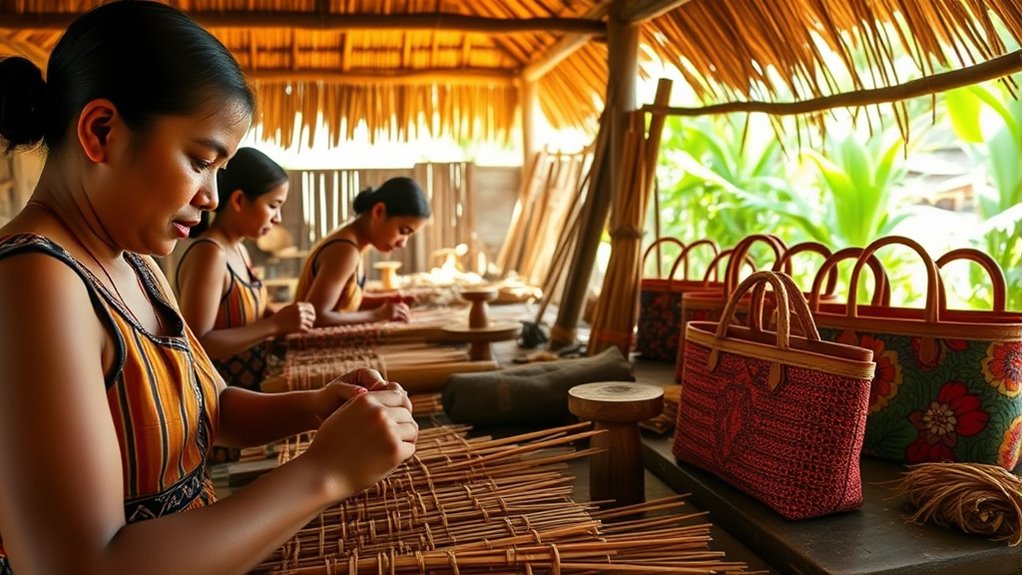
What sets Bali’s artisan handbags apart are the intricate craftsmanship and traditional techniques passed down through generations. Bead embroidery is a hallmark, where artisans meticulously sew colorful beads onto leather or fabric, creating detailed patterns that reflect local culture. This technique requires patience and precision, making each piece unique. Natural dyeing also plays a crucial role, using plant-based dyes to color materials sustainably. Artisans source natural pigments from local plants, ensuring vibrant hues that age beautifully over time. These methods not only preserve Bali’s rich heritage but also produce handbags with distinct textures and deep, authentic colors. By combining bead embroidery and natural dyeing, Balinese artisans create accessories that are both visually stunning and culturally meaningful. Understanding traditional techniques enhances appreciation for the craftsmanship involved in each handbag.
The Impact of Sustainability on Local Artisans
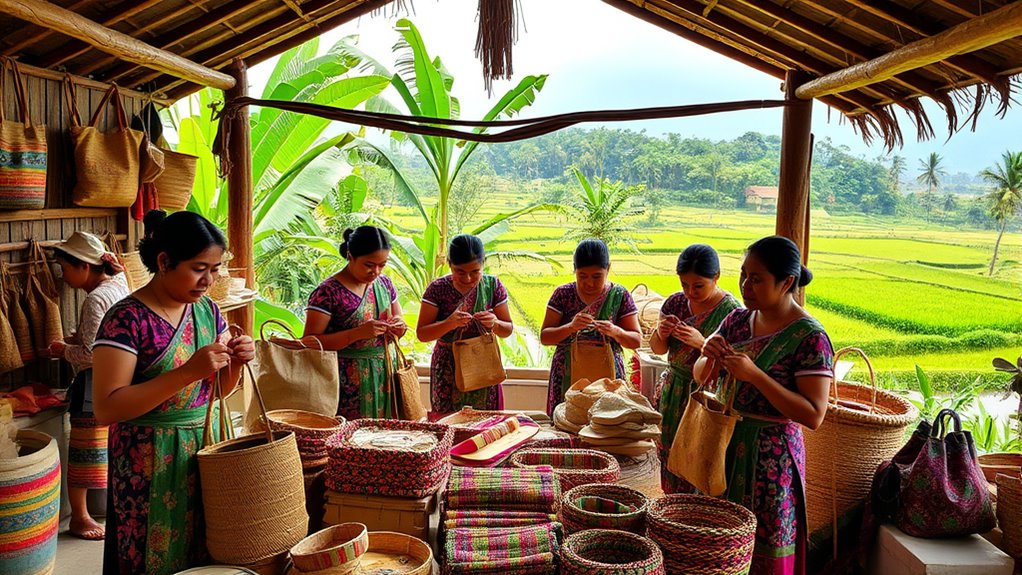
Sustainable practices are transforming how local artisans craft and sell their handbags, fostering a deeper connection between tradition and environmental responsibility. By using eco friendly materials, artisans reduce their environmental impact while maintaining the quality and authenticity of their work. Fair trade practices ensure that artisans receive fair compensation for their craftsmanship, empowering them to sustain their livelihoods and invest in their communities. This shift encourages a more conscious consumer base, enthusiastic to support ethically produced products. As a result, artisans feel valued and motivated to continue their craft with integrity. Sustainability not only preserves Bali’s cultural heritage but also promotes economic stability for local artisans. Incorporating dog names into branding and storytelling can further humanize and personalize these artisan products, connecting consumers more deeply with the artisans’ stories. Embracing these practices helps create a more equitable and environmentally friendly handbag industry in Bali.
Spotlight on Prominent Bali Handbag Collectives
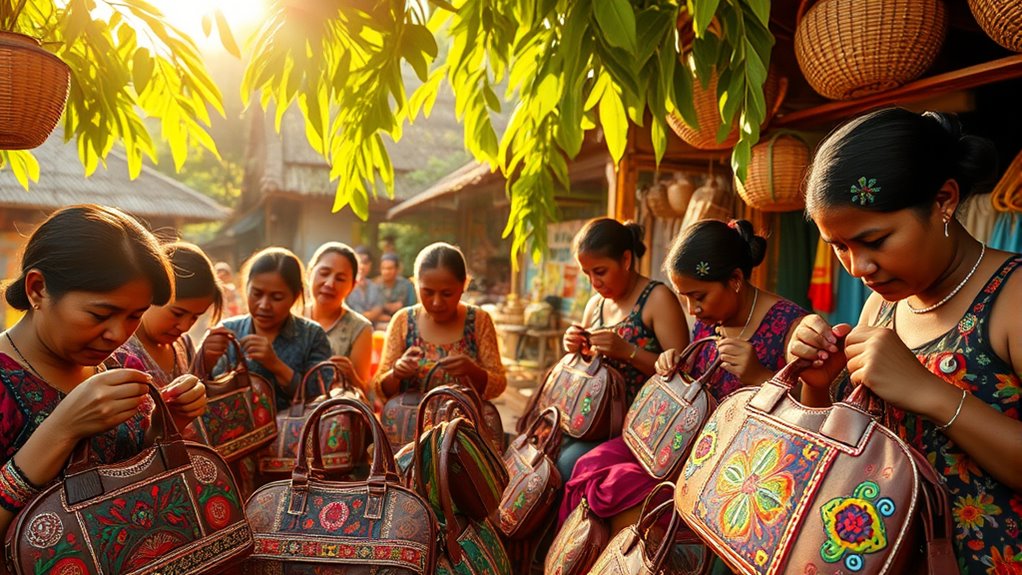
Several prominent handbag collectives in Bali are gaining recognition for their craftsmanship and commitment to ethical practices. These collectives have built strong reputations through luxury branding that emphasizes quality, sustainability, and authentic artistry. Many have attracted celebrity endorsements, boosting their visibility on the global stage and positioning Bali as a key player in high-end fashion. Their unique designs often blend traditional techniques with modern aesthetics, making them highly desirable among discerning buyers. By focusing on ethical sourcing and fair labor practices, these collectives appeal to consumers seeking both luxury and social responsibility. As a result, they are elevating Bali’s reputation in the luxury handbag market, drawing attention from influencers and fashion icons worldwide. Their success highlights Bali’s position as a hub for innovative, ethically driven craftsmanship. Additionally, these collectives are increasingly integrating ethical sourcing and sustainability into their production processes to meet growing consumer demand for responsible fashion.
How These Collectives Are Shaping Global Fashion Trends
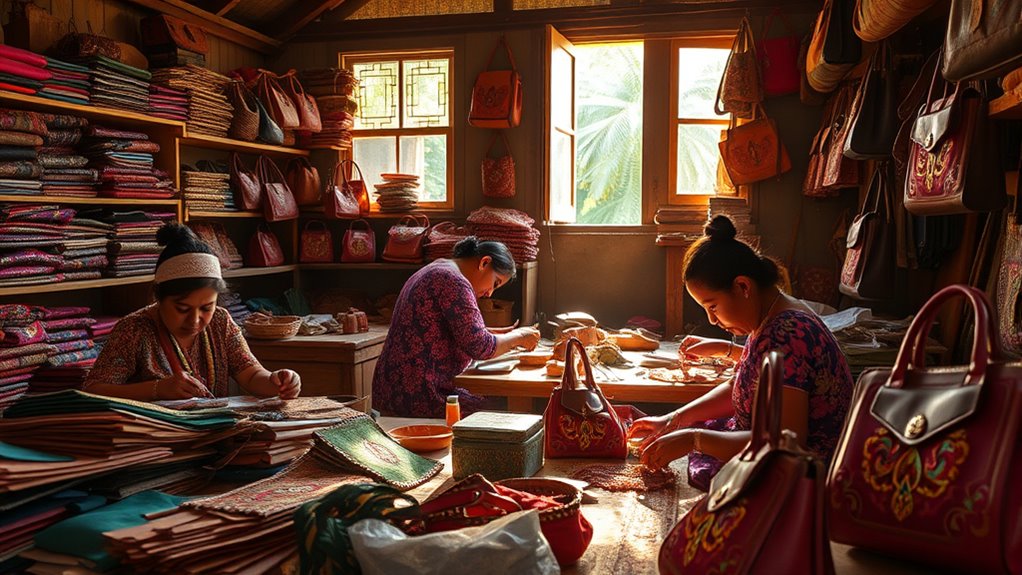
You notice how authenticity is driving demand for Bali’s handcrafted bags, making them a must-have worldwide. Sustainable craftsmanship is gaining recognition, inspiring brands to prioritize ethical practices. These collectives showcase cultural identity through their designs, influencing global fashion with genuine stories and traditions. Additionally, the emphasis on craftsmanship quality ensures that these bags meet high standards, boosting their appeal in international markets.
Authenticity Drives Demand
Authenticity has become a powerful driver of demand in the global fashion scene, especially for artisan handbag collectives in Bali. Consumers now seek genuine stories behind their products, valuing craftsmanship over mass production. These collectives leverage authenticity to elevate their luxury branding, making their bags more desirable worldwide. Celebrity endorsements further boost their credibility, as influencers and celebrities showcase their unique pieces, emphasizing the handcrafted quality and cultural heritage. This trend shifts the focus from fleeting trends to meaningful, authentic products that resonate emotionally with buyers. As a result, demand for these Bali-made handbags grows, shaping global fashion trends that favor transparency, cultural appreciation, and true craftsmanship over superficial luxury. Incorporating transparent supply chains helps these brands build trust and connect more deeply with conscious consumers. Your appreciation for authenticity now aligns with a broader movement towards more conscious consumption.
Sustainable Craftsmanship Gains Recognition
As sustainability becomes a central concern in fashion, Bali’s artisan handbag collectives are gaining recognition for their commitment to eco-friendly practices. These collectives prioritize eco friendly materials, reducing environmental impact while creating beautiful, durable products. Through artisan collaborations, skilled craftspeople combine traditional techniques with modern design, elevating their craft on a global stage. This movement promotes transparency and responsible sourcing, inspiring consumers to make conscious choices. Additionally, incorporating color accuracy in their designs ensures the vibrant and authentic representation of traditional patterns and modern aesthetics.
Cultural Identity in Design
Bali’s artisan handbag collectives are shaping global fashion trends by infusing their designs with rich cultural identity. They incorporate cultural symbolism, turning traditional motifs into modern statement pieces that resonate worldwide. Each handbag becomes a canvas for artistic expression, blending indigenous techniques with contemporary styles. These designs reflect Bali’s history, beliefs, and customs, allowing you to carry more than just a fashion accessory—you carry a story. As these collectives gain international recognition, they influence mainstream fashion by emphasizing authenticity and cultural depth. Your choices help elevate traditional craftsmanship while promoting a deeper appreciation for Bali’s heritage. Additionally, the use of aesthetic wall organization systems can enhance the presentation of these unique handbags in retail spaces, further elevating their appeal. By supporting these collectives, you become part of a movement that values cultural preservation through innovative, expressive design.
Challenges and Opportunities for Bali’s Artisan Handbag Movement
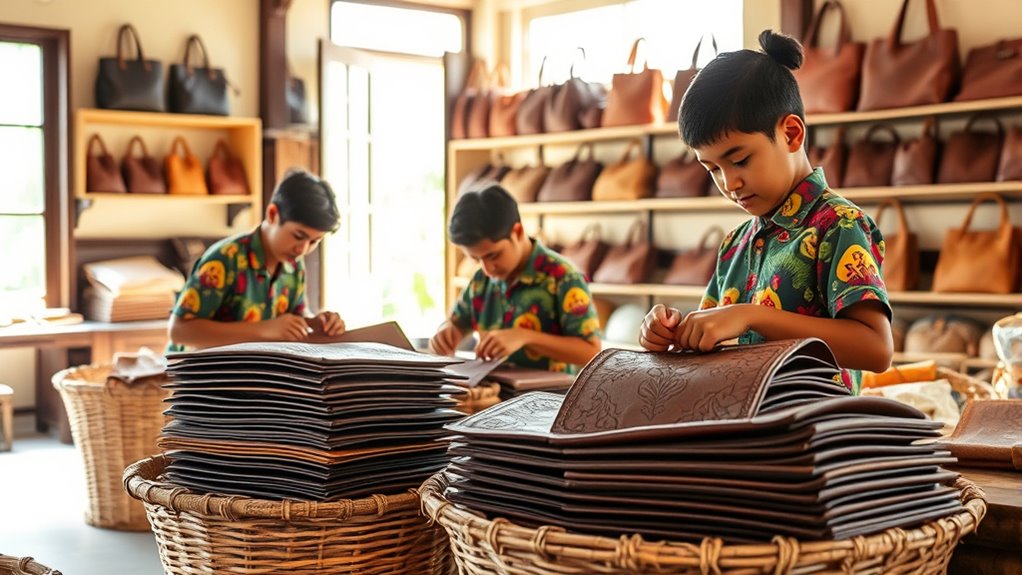
As Bali’s artisan handbag movement grows, you’ll face fierce market competition and the challenge of maintaining authentic craftsmanship. Balancing sustainable growth with increased demand requires strategic planning and innovation. Exploring these opportunities and obstacles will help shape the future of Bali’s unique artisan scene. Developing strong leadership skills can empower artisans to navigate these challenges effectively and foster collaborative growth.
Market Competition Dynamics
While the vibrant artisan handbag scene in Bali presents exciting opportunities, it also faces stiff competition from both local and international brands. You need to navigate a crowded market where price competition often pressures margins. Strong branding strategies become essential to differentiate your products and build customer loyalty. To succeed, consider these factors:
- Developing a unique story that resonates with consumers
- Offering craftsmanship that surpasses mass-produced alternatives
- Pricing products strategically without undervaluing quality
- Building an online presence to reach global markets
- Incorporating distinctive design elements that highlight the artisanal quality and set your brand apart in a competitive landscape
Balancing affordability with exclusivity can help attract diverse buyers. Staying innovative in your marketing and maintaining high standards are vital to standing out amid fierce competition. This environment pushes you to sharpen your brand’s identity and value proposition continually.
Preservation of Craftsmanship
Amid fierce market competition, preserving the authentic craftsmanship behind Bali’s artisan handbags faces significant hurdles. As luxury branding becomes essential for standing out, artisans often feel pressure to adopt mass-produced techniques that compromise traditional skills. Celebrity influence helps elevate these handbags’ status but can also create unrealistic expectations, pushing artisans toward shortcuts. The challenge lies in maintaining genuine craftsmanship while appealing to high-end markets and celebrity endorsements. Opportunities exist to reinforce the value of handcrafted work through storytelling that highlights cultural heritage. By aligning luxury branding with authentic techniques, you can preserve Bali’s craftsmanship and meet the demands of discerning buyers. Ultimately, balancing commercial success with cultural integrity is key to safeguarding Bali’s artisan handbag legacy.
Sustainable Growth Strategies
To guarantee the sustainable growth of Bali’s artisan handbag movement, artisans and stakeholders must navigate a complex landscape of challenges and opportunities. Effective branding strategies are essential to stand out in competitive markets and build a strong identity. Expanding into export markets offers growth potential but requires understanding international preferences and regulations. Consider these key points:
- Developing a cohesive brand story that highlights Bali’s craftsmanship
- Building relationships with global distributors and boutiques
- Adapting designs to suit diverse cultural tastes
- Ensuring quality control to meet international standards
Frequently Asked Questions
How Do Bali’S Artisan Handbag Collectives Influence Local Community Development?
You see how artisan handbag collectives boost local community development by fostering artisan empowerment and cultural preservation. These collectives provide artisans with fair wages, skill training, and a platform to showcase their craftsmanship. As a result, communities thrive economically and culturally, maintaining traditional techniques while gaining global recognition. Your support helps sustain these initiatives, ensuring artisans can prosper and cultural heritage remains vibrant for future generations.
What Are the Most Popular Materials Used in Bali’S Artisan Handbags?
Imagine holding a piece of Bali’s vibrant craftsmanship—what materials make these handbags so special? You’ll find sustainable sourcing at the heart, with natural fibers like rattan, bamboo, and water hyacinth, combined with innovative designs using leather and textiles. These materials reflect Bali’s rich cultural heritage and eco-conscious spirit, making each handbag unique. By choosing these, you support artisans and promote environmentally friendly practices, turning everyday accessories into meaningful art.
How Do Artisans Ensure Traditional Techniques Are Preserved Amid Modern Trends?
You can see artisans guarantee cultural preservation and skill transfer by actively passing down traditional techniques through apprenticeships and workshops. They often work with community elders to maintain authenticity and adapt modern trends without losing heritage. By blending new designs with age-old methods, artisans keep traditions alive, allowing craftsmanship to thrive while meeting contemporary demands. This dedication ensures Bali’s artisan handbag techniques remain vibrant and culturally significant for future generations.
What Role Do Government Policies Play in Supporting Bali’S Handbag Collectives?
Coincidentally, government policies play a vital role in supporting Bali’s handbag collectives. You’ll find that policy support and clear licensing regulations help artisans access resources, gain legitimacy, and expand their markets. When the government streamlines licensing regulations and offers incentives, it encourages craftsmanship preservation while fostering innovation. Your collective benefits from these policies, ensuring traditional techniques thrive amidst modern trends, and the local economy grows stronger through sustainable artisan enterprises.
How Do Bali’S Handbag Collectives Access International Markets and Buyers?
You can access international markets and buyers through effective export strategies and digital marketing. By showcasing your handbags online, you reach a global audience, making it easier to attract international customers. Utilizing social media, e-commerce platforms, and targeted advertising helps you build brand awareness worldwide. Developing strong relationships with export partners and participating in international trade fairs also open doors to new markets, boosting your collective’s growth and success.
Conclusion
As you explore Bali’s artisan handbag scene, you’re stepping into a vibrant tapestry woven with tradition and innovation. These collectives are like a blooming garden, blending craftsmanship, sustainability, and global influence. By supporting them, you help nurture this beautiful ecosystem, ensuring it thrives for generations. Embrace this movement, and watch how each bag tells a story—your story—while contributing to Bali’s ever-growing legacy of artistry and resilience.









